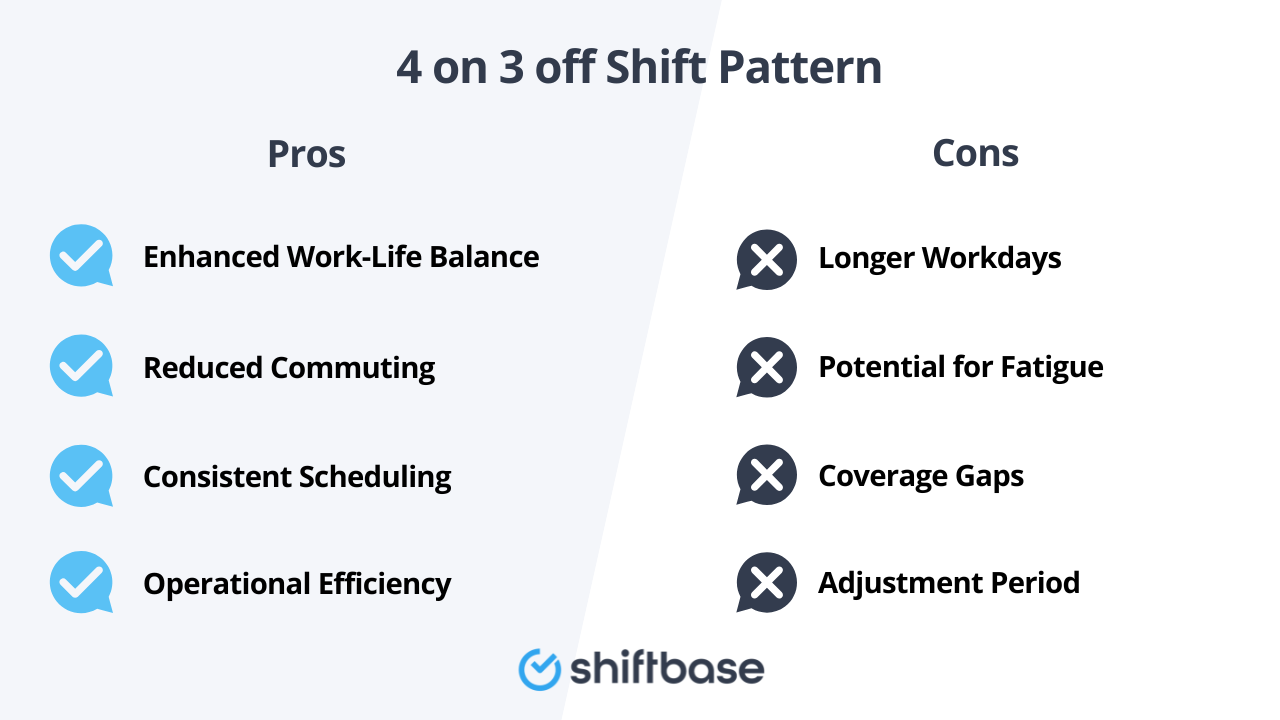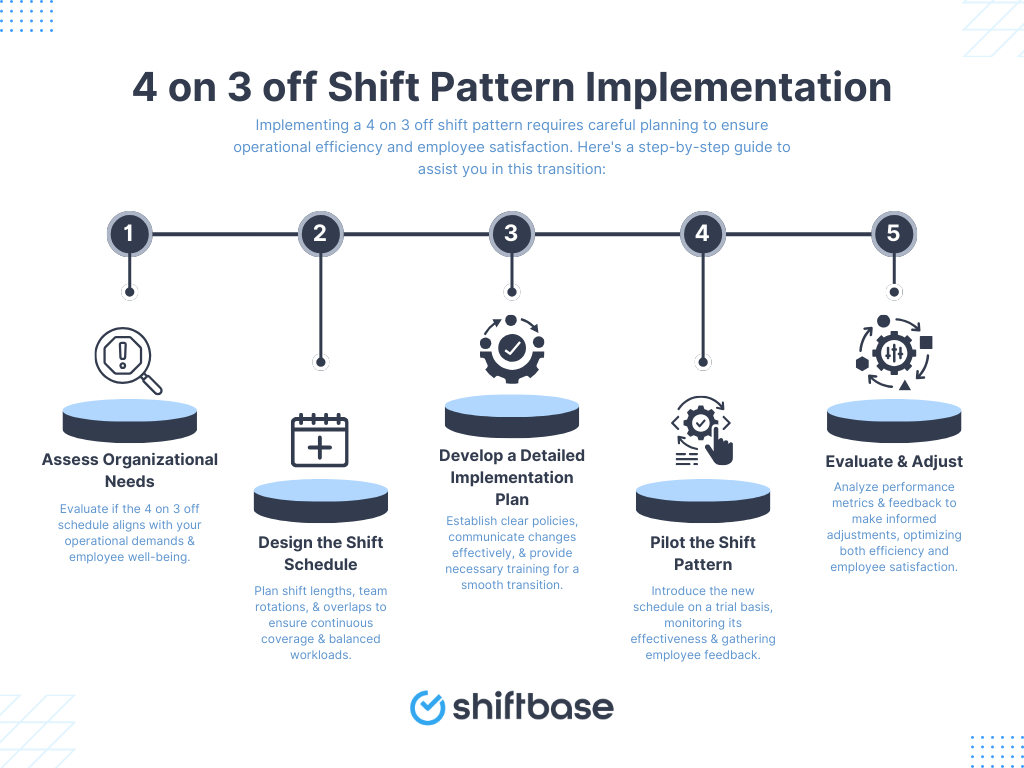This article dives into what the 4 on 3 off shift pattern entails and how it compares to the traditional work schedule, providing valuable insights for employers, HR professionals, and small business owners.
What is a 4 on 3 off-shift pattern?
The 4 on 3 off shift pattern is a type of work shift schedule where employees work for four consecutive days, followed by three days off. This pattern can be applied to any time of the day, whether it's a day shift, night shift, or even rotating shifts.
- Shift Duration: In this schedule, employees typically work shifts lasting around 10 hours.
- Rotational Structure: The system operates on a rotating basis, ensuring full coverage throughout the week while providing employees with a short 'weekend' break.
- Team Collaboration: Generally, multiple teams are coordinated to maintain uninterrupted operations. Each team rotates through the schedule to cover all necessary time slots required by the employer.
Pros and cons of the 4 On 3 shift pattern
In workplaces, the "4 on 3 off schedule" offers several benefits that can improve the lives of employees and the efficiency of operations.
Pros
- Enhanced work-life balance: One significant advantage is the enhanced work-life balance it provides. With four days of work followed by three days off, employees have more time to dedicate to their social and family life. This consistent schedule allows them to plan activities during their days off, making it easier to maintain a healthy work-life balance.
- Reduced Commuting: Working fewer days per week decreases the frequency of commutes, saving time and transportation costs for employees.
- Consistent Scheduling: The regularity of the 4 on 3 off pattern enables employees to plan their personal lives more effectively around their work schedule.
- Operational Efficiency: For employers, this shift pattern can provide continuous coverage and align staffing levels with peak operational demands, especially in industries requiring 24/7 operations.
Cons
-
Longer Workdays: To maintain full-time hours, employees may need to work longer shifts (e.g., 10-hour days), which can lead to fatigue and decreased productivity over extended periods.
-
Potential for Fatigue: Extended work hours over consecutive days can increase the risk of employee burnout, particularly if the nature of the work is physically or mentally demanding.
-
Coverage Gaps: Employers might face challenges ensuring adequate coverage during the three-day off period, potentially requiring the use of additional staff or overtime.
-
Adjustment Period: Employees transitioning from traditional 5-day workweeks may require time to adapt to the new schedule, and some may find the longer workdays challenging.
It's essential for employers to weigh these pros and cons in the context of their specific operational needs and workforce preferences when considering the implementation of a 4 on 3 off shift pattern.

Example of the 4 on 3 off shift pattern
Let's consider a hospital as an example of where the 4 on 3 off-shift pattern can be applied effectively. In this setting, rotating shift schedules are common due to the need for 24-hour patient care.
Day shifts (7 AM - 7 PM)
-
Group A: Employees in this group work four consecutive 12-hour day shifts, covering the early morning to late afternoon hours.
-
Group B: A second set of employees follows a similar schedule to Group A, ensuring round-the-clock coverage for daytime shifts.
After these four consecutive 12-hour shift schedules, they get three days off.
Night shifts (7 PM - 7 AM)
-
Group C: This group of healthcare professionals takes on four consecutive 12-hour night shifts, spanning from early evening to early morning.
-
Group D: Like Group C, another team is assigned to overnight shifts, ensuring uninterrupted care during nighttime hours.
After these four consecutive 12-hour shift schedules, they get three days off.
Rotating schedule
-
The 4 on 3 off pattern can include swing shifts, where employees transition between day and night shifts to distribute the workload effectively.
-
Overlapping shifts can be incorporated to ensure a seamless transition between teams during shift changes.
This structured example showcases how the 4 on 3 off shift pattern can be implemented in a healthcare environment. It provides continuous care coverage while offering employees a balanced mix of day and night shifts, contributing to employee satisfaction and the efficient management of shift schedules.
How to effectively implement a 4 on 3 off schedule?
mplementing a 4 on 3 off shift pattern, where employees work four consecutive days followed by three days off, requires careful planning to ensure operational efficiency and employee satisfaction. Here's a step-by-step guide to assist you in this transition:
1. Assess Organizational Needs
-
Operational Requirements: Determine if the 4 on 3 off schedule aligns with your business operations, especially regarding coverage during peak hours and the necessity for 24/7 staffing.
-
Employee Considerations: Evaluate the potential impact on employee well-being, considering factors like longer workdays and the balance between work and personal life.
2. Design the Shift Schedule
-
Shift Length: Decide on appropriate shift durations, typically around 10 hours, to ensure full coverage without overburdening employees.
-
Team Structuring: Organize multiple teams to rotate through the schedule, ensuring continuous operations and equitable distribution of workloads.
-
Overlap Planning: Incorporate overlapping shifts to facilitate smooth transitions and minimize coverage gaps during shift changes.
3. Develop a Detailed Implementation Plan
-
Policy Formulation: Establish clear policies and protocols that support the new schedule, including attendance expectations, overtime regulations, and procedures for shift swaps.
-
Communication Strategy: Clearly communicate the upcoming changes to all employees, providing ample time for them to adjust and voice any concerns.
-
Training Sessions: Conduct training to familiarize staff with the new schedule and address any operational adjustments required.
4. Pilot the Shift Pattern
-
Trial Period: Implement the new schedule on a trial basis to monitor its effectiveness and identify any unforeseen challenges.
-
Feedback Collection: Encourage employee feedback during the trial to gauge satisfaction levels and gather suggestions for improvement.
5. Evaluate and Adjust
-
Performance Metrics: Analyze key performance indicators (KPIs) such as productivity levels, employee attendance, and overall morale to assess the impact of the new shift pattern.
-
Continuous Improvement: Be prepared to make necessary adjustments based on feedback and performance data to optimize the schedule for both operational efficiency and employee satisfaction.
By following these steps, you can effectively implement a 4 on 3 off shift pattern that meets your organization's needs while promoting a positive work environment for your employees.

Industries that use 4 on 3 off shift pattern
The 4 on 3 off shift pattern, where employees work four consecutive days followed by three days off, is commonly utilized in various industries to ensure continuous operations and maintain employee well-being. Notable sectors implementing this schedule include:
1. Manufacturing
Manufacturing facilities often require round-the-clock production to meet demand and maintain efficiency. The 4 on 3 off schedule allows for continuous operation with multiple teams rotating shifts, ensuring that machinery and production lines remain active without interruption.
2. Healthcare
Hospitals and healthcare facilities operate 24/7 to provide essential medical services. Implementing a 4 on 3 off shift pattern helps distribute workloads evenly among medical staff, such as nurses and technicians, while offering them regular extended rest periods to prevent burnout and maintain high-quality patient care.
3. Emergency Services
Emergency services, including police, fire departments, and ambulance services, require constant readiness to respond to incidents. The 4 on 3 off schedule ensures that personnel are available at all times, with teams rotating to provide seamless coverage and quick response capabilities.
4. Utilities
Industries such as energy and water supply need continuous monitoring and maintenance to ensure service reliability. Adopting a 4 on 3 off shift pattern allows utility companies to staff control rooms and field operations effectively, maintaining consistent service delivery.
5. Customer Service
Businesses that offer 24/7 customer support, such as call centers and online service providers, benefit from the 4 on 3 off schedule. This shift pattern enables them to provide uninterrupted assistance to clients across different time zones, enhancing customer satisfaction.
Implementing the 4 on 3 off shift pattern in these industries helps balance operational demands with employee well-being, contributing to sustained productivity and service quality.
Conclusion
The 4 on 3 off shift pattern offers a valuable approach to enhance productivity and work-life balance in today's evolving workplace. It provides employees with extended periods of rest and can be particularly effective in industries requiring continuous operations.
While implementation may pose challenges, careful planning, employee involvement, and the use of technology can address them effectively. Ultimately, the decision to adopt this schedule should be based on your business's unique needs, industry, and the shift preferences of your workforce.
Streamlining 4 on 3 Off Schedules with Shiftbase
Adopting the 4 on 3 off shift pattern is made efficient and effortless with Shiftbase. This innovative employee scheduling software simplifies the process of organizing and managing this unique shift pattern, ensuring operational continuity and employee satisfaction.
Complemented by Shiftbase's time tracking feature, monitoring and managing work hours becomes more accurate and streamlined, crucial for a schedule that offers a balance between work and rest.
Additionally, the absence management system is invaluable in maintaining optimal staffing levels. Experience how Shiftbase can revolutionize your scheduling needs by signing up for a 14-day free trial here. Transform your workforce management with Shiftbase today.

Your work schedule in one central place!




